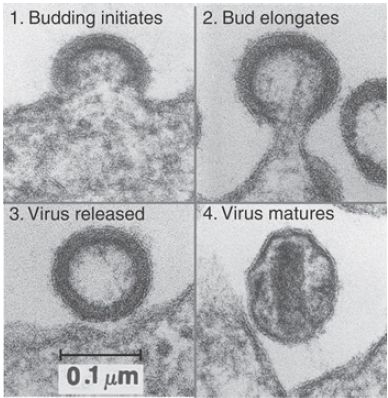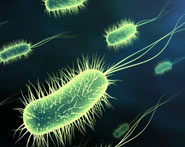


 النبات
النبات
 الحيوان
الحيوان
 الأحياء المجهرية
الأحياء المجهرية
 علم الأمراض
علم الأمراض
 التقانة الإحيائية
التقانة الإحيائية
 التقنية الحيوية المكروبية
التقنية الحيوية المكروبية
 التقنية الحياتية النانوية
التقنية الحياتية النانوية
 علم الأجنة
علم الأجنة
 الأحياء الجزيئي
الأحياء الجزيئي
 علم وظائف الأعضاء
علم وظائف الأعضاء
 الغدد
الغدد
 المضادات الحيوية
المضادات الحيويةRetroviral Genes Code for Polyproteins
KEY CONCEPTS
- A typical retrovirus has three genes: gag, pol, and env.
- The Gag and Pol proteins are translated from a fulllength transcript of the genome.
- Translation of Pol requires a frameshift by the ribosome.
- Env is translated from a separate mRNA that is generated by splicing.
- Each of the three protein products is processed by proteases to give multiple proteins.
A typical retroviral sequence contains three or four “genes.” (In this context, the term gene is used to identify coding regions, each of which actually gives rise to multiple proteins by processing reactions.) A typical retrovirus genome with three genes is organized in the sequence gag-pol-env, as indicated in FIGURE 1.

FIGURE 1. The genes of the retrovirus are expressed as polyproteins that are processed into individual products.
Retroviral mRNA has a conventional structure; it is capped at the 5′ end and polyadenylated at the 3′ end. It is represented in two mRNAs. The full-length mRNA is translated to give the Gag and Pol polyproteins. The Gag product is translated by reading from the initiation codon to the first termination codon. This termination codon must be bypassed to express Pol.
Different mechanisms are used in different viruses to proceed beyond the gag termination codon, depending on the relationship between the gag and pol reading frames. When gag and pol follow continuously, suppression by a glutamyl-tRNA that recognizes the termination codon allows a single protein to be generated. When gag and pol are in different reading frames, a ribosomal frameshift occurs to generate a single protein. Usually the readthrough is about 5% efficient, so Gag protein outnumbers Gag-Pol protein about 20-fold.
The Env polyprotein is expressed by another means: Splicing generates a shorter subgenomic mRNA that is translated into the Env product.
The gag gene gives rise to the protein components of the nucleoprotein core of the virion. The pol gene encodes proteins with functions in nucleic acid synthesis and recombination. The env gene encodes components of the envelope of the particle, which also sequesters components from the cellular cytoplasmic membrane.
Both the Gag or Gag-Pol and the Env products are polyproteins that are cleaved by a protease to release the individual proteins that are found in mature virions. The protease activity is encoded by the virus in various forms: It may be part of Gag or Pol, and at times it takes the form of an additional independent reading frame.
The production of a retroviral particle involves packaging the RNA into a core, surrounding it with capsid proteins, and pinching off a segment of membrane from the host cell. The release of infective particles by such means is shown in FIGURE 2. The process is reversed during infection: A virus infects a new host cell by fusing with the plasma membrane and then releasing the contents of the virion.

FIGURE 2. Retroviruses (HIV) bud from the plasma membrane of an infected cell.
Photos courtesy of Matthew A. Gonda, Ph.D., Partner at Power Ten Medical Ventures, Inc.



|
|
|
|
للتخلص من الإمساك.. فاكهة واحدة لها مفعول سحري
|
|
|
|
|
|
|
العلماء ينجحون لأول مرة في إنشاء حبل شوكي بشري وظيفي في المختبر
|
|
|
|
|
|
|
قسم العلاقات العامّة ينظّم برنامجاً ثقافياً لوفد من أكاديمية العميد لرعاية المواهب
|
|
|